Chestnut Rice, or Kuri Gohan, is a traditional Japanese mixed rice recipe made in the fall when sweet and nutty Japanese chestnuts are in season. This fragrant and comforting dish is perfect for cozy autumn evenings.

Autumn brings an abundance of delicious seasonal produce like Japanese chestnuts. Each fall, I eagerly anticipate the special dishes we make with them like today’s recipe for nutty and sweet Japanese Chestnut Rice (Kuri Gohan). It’s one of the signature dishes that marks the arrival of autumn in Japan—a fragrant, comforting dish that brings back fond memories.
For more rice dishes featuring fall produce, try my Japanese Sweet Potato Rice, Matsutake Gohan (Wild Pine Mushroom Rice), and Japanese Mushroom Rice next!
What is Chestnut Rice (Kuri Gohan)?
Chestnut rice, or kuri gohan (栗ご飯), is a traditional Japanese dish made with rice (gohan) and fresh Japanese chestnuts (kuri), two autumn crops in Japan. Kuri is culturally significant in Japan, serving since ancient times as an important food source during autumn and winter. It’s also believed to bring good luck and fortune. Today, we enjoy their deep nutty aroma and sweet flesh in delicious dishes like kuri gohan as a wonderful way to welcome the season.

Table of Contents
Why I Love This Recipe
- What a special, seasonal dish! Chestnuts are a precious cultural ingredient in Japan. When I make this dish, it sparks conversation and a cultural connection with my kids.
- Simple yet strikingly impressive. The beauty of this rice dish lies in its simplicity. The appearance of chestnuts captures the essence of fall and evokes a sense of nostalgia.
- Its aromatic flavor and fluffy texture are irresistible. There’s nothing like the combination of fresh Japanese chestnuts and new crop short-grain rice. I hope you give this recipe a try!
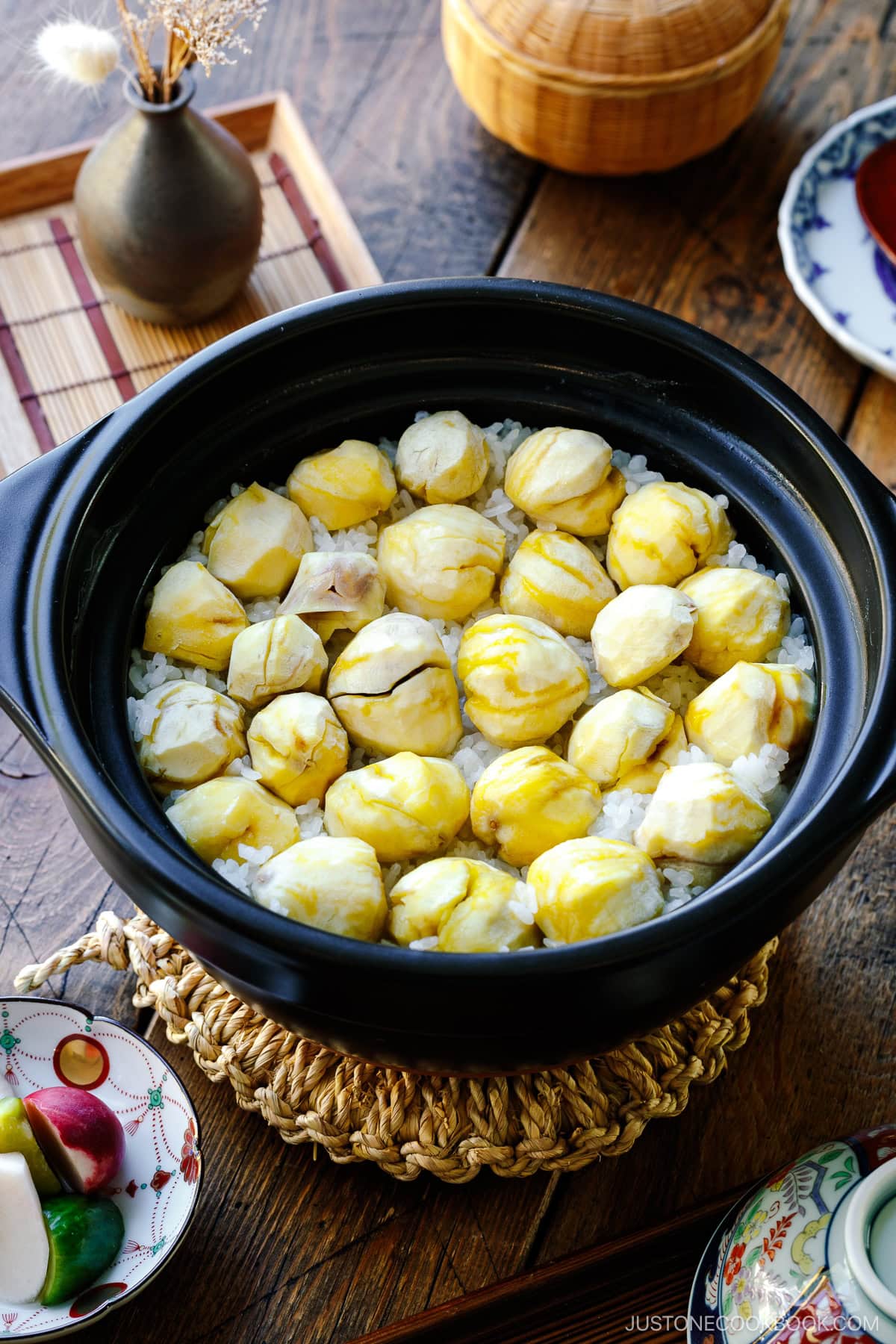
Ingredients for Chestnut Rice
- Fresh Japanese chestnuts
- Japanese short-grain white rice
- Japanese short-grain glutinous rice (sweet rice)
- Sake
- Salt
Find the printable recipe with measurements below.
Jump to RecipeSubstitutions
- Japanese rice: I highly recommend using Japanese short-grain rice here, as its texture and flavor differ significantly from other varieties. You can also use Korean short-grain rice, which is the closest alternative.
- Glutinous rice: I add Japanese short-grain glutinous rice to the mix for a slightly chewy and more tender texture. If you don’t have it, you can use Japanese short-grain rice instead.
- Sake: We add sake to infuse the rice and ingredients with flavor that enhances the richness and umami of the mixed rice. If you don’t have it, you can just skip it.
Key Equipment
- A heavy-bottomed pot – I use a Hario Gohangama donabe, a Japanese ceramic/earthenware pot, but you can use a Dutch oven instead. You can also make this recipe using a rice cooker; simply press start and cook as usual.

How To Make Chestnut Rice (Kuri Gohan)
Preparation
Step 1 – Remove the tough outer shell and the thin, papery inner skin. Soak the chestnuts in warm water for 30 minutes. For each chestnut, use a knife to remove the tough bottom, then peel off a strip along one side moving toward the tip. Peel away the outer shell with your fingers. The papery skin usually comes off with the shell.

Step 2 – Peel away the bumpy flesh and shape the chestnuts. For a more attractive presentation, it’s best to make large cuts on the surface of the chestnuts to resemble the facets of a diamond.

Step 3 – Soak the chestnuts in water for at least 30 minutes. This helps remove astringency and yields a beautiful creamy yellow color. Don’t skip this step.

Assemble
Step 4 – Put everything in the pot. Add the rinsed and well-drained rice, measured water, and seasonings to the pot. Then, place the chestnuts on top in a single layer so they cook evenly. Soak for 20–30 minutes before cooking to allow the rice’s core to absorb moisture.

Cooking
Step 5 – Cook and steam the chestnut rice. For my donabe rice pot, I cook on medium-high heat for 12–13 minutes. When the cooking time is up, remove it from the heat and let it steam with the lid on for 15–20 minutes.

Step 6 – Fluff the rice. Set aside several beautiful chestnuts for serving, then gently fluff the rice with the rest of the chestnuts.


Step 7 – Serve. Serve in individual rice bowls and sprinkle with black sesame seeds and salt.
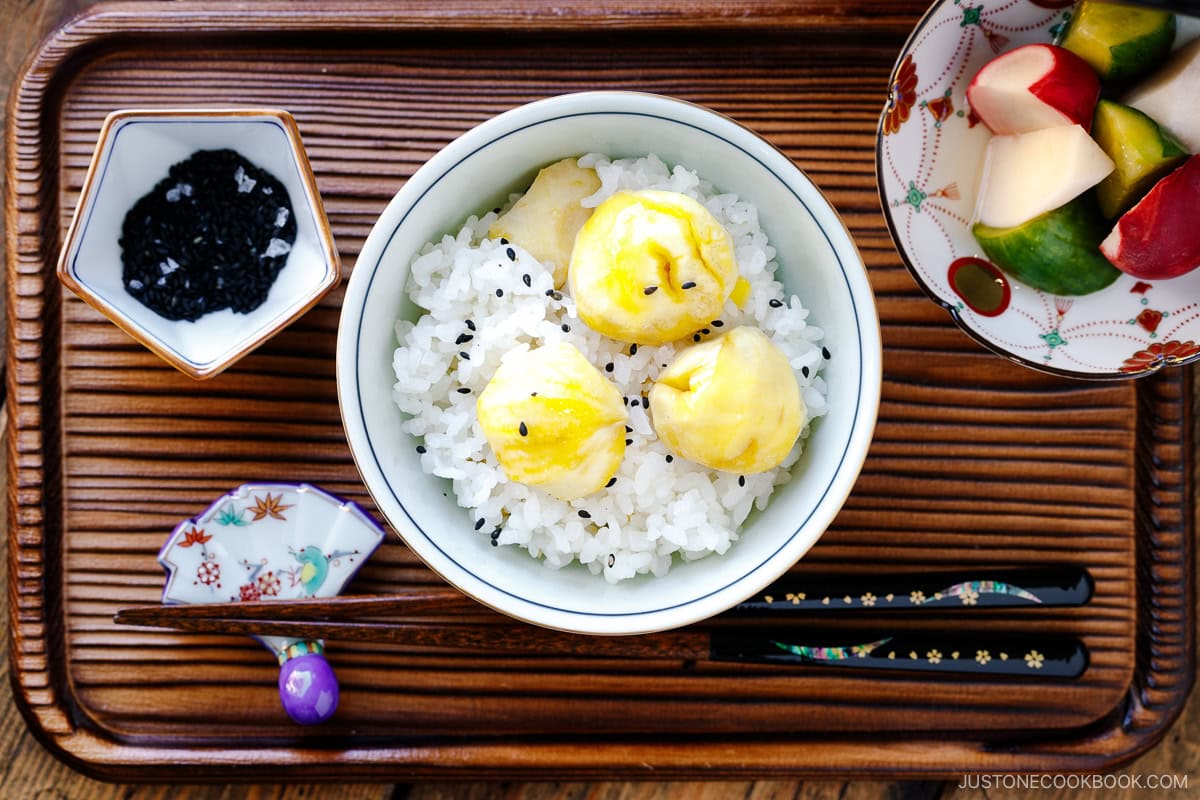
Nami’s Recipe Tips
- Get fresh chestnuts and use them within 3 days. I recommend storing them in the fridge in a breathable bag.
- Soak in warm water before peeling for 30 minutes. Some Japanese recipes use cold water, but I find that warm water helps. To keep the chestnuts moist and fragrant, we typically do not boil or roast them before cooking with the rice.
- Soak in cold water after peeling for 30 minutes. This helps create a beautiful yellow color. Without soaking, the chestnut will turn brown. Be sure to change the water a few times during this soaking period.
- Reserve some chestnuts for presentation. Once the chestnut rice is done steaming, remove several beautiful chestnuts from the pot to use for presentation when serving. They break easily after fluffing the rice, so it’s a good idea to set aside some whole chestnuts.
Variations and Customizations
- Enhance the flavor with dried kelp seaweed. Some people add a small piece of kombu between the rice and chestnut layers during cooking to increase umami and aroma.
- Add more seasonings. I keep my seasonings simple to let the naturally sweet and nutty chestnut flavor shine. If you wish, you can add a bit of soy sauce and/or mirin (Japanese sweet rice wine) to the cooking liquid in addition to the sake and salt. Just be sure to reduce the amount of water in the recipe; you’ll want to keep the overall measurement of cooking liquid the same.
- Skip the glutinous rice. You can make chestnut rice without glutinous rice. It will be less soft and tender overall, but it won’t become too hard the next day since there is no glutinous rice in it.
What To Serve with Chestnut Rice
I enjoy serving fragrant chestnut rice with various side dishes to create a full meal. Here are some suggestions, but feel free to mix and match:
- Sanma Shioyaki – This classic autumn grilled fish is a perfect pairing!
- Stir-Fried Bitter Melon and Eggplant with Miso – Add more textural contrast to the meal with this unique stir-fry.
- Kinpira Renkon – Another fall favorite, lotus root is a great side dish if you enjoy its crisp and tender texture.
- Miso Soup with Enoki Mushrooms and Ground Sesame – This soup will warm you right up on a cool fall evening.

Storage and Reheating Tips
To store: You can keep the leftovers in an airtight container and store in the freezer for up to a month.
To reheat: Take out the glass container of frozen rice from the freezer. Remove the lid and loosely cover the rice with a paper towel. Then, microwave until the rice is hot all the way through.
Frequently Asked Questions
I can usually peel a chestnut shell by holding it in one hand and a pairing knife in the other. However, if the shell is tough and stubborn, place the chestnut on a cutting board to cut off the bottom, and then pick it up to peel off the shell.
Depending on the chestnut, the outer shell and papery inner skin may come off together. If the inner skin is still attached to the yellow flesh, then thinly peel off the bumpy flesh and papery inner skin together with the knife.
Unfortunately, no. I developed this recipe to use Japanese chestnuts, which are much larger than American/European chestnuts. Their cooking methods differ as well, since American/European chestnuts are typically roasted, not boiled. If you end up trying with them, let us know how it went. Please be careful removing the tough skin!
More Mixed Rice Recipes
There are so many ways to prepare Japanese mixed rice, and I think you’re going to enjoy these delicious recipes, too:


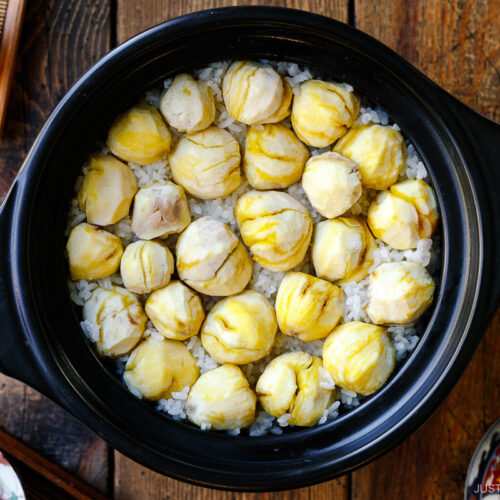
Chestnut Rice (Kuri Gohan)
Ingredients
- 20–25 chestnuts (if your chestnuts are big, use fewer and cut them in half after peeling and soaking)
- 1⅞ cups uncooked Japanese short-grain white rice (2.5 rice cooker cups; 450 ml)
- ⅓ cup sweet rice/glutinous rice (mochigome) (½ rice cooker cup; 90 ml; or use regular short-grain rice)
- 2¼ cups water
- 1 Tbsp sake
- ½ tsp Diamond Crystal kosher salt
For the Toppings
- toasted black sesame seeds (optional)
- Diamond Crystal kosher salt (optional)
Instructions
- Gather all the ingredients.

To Prepare the Chestnuts
- Soak 20–25 chestnuts in warm water for at least 30 minutes. Some Japanese recipes use cold water, but I find warm water helps. To keep the chestnuts moist and fragrant, we typically do not boil or roast them before cooking with the rice.
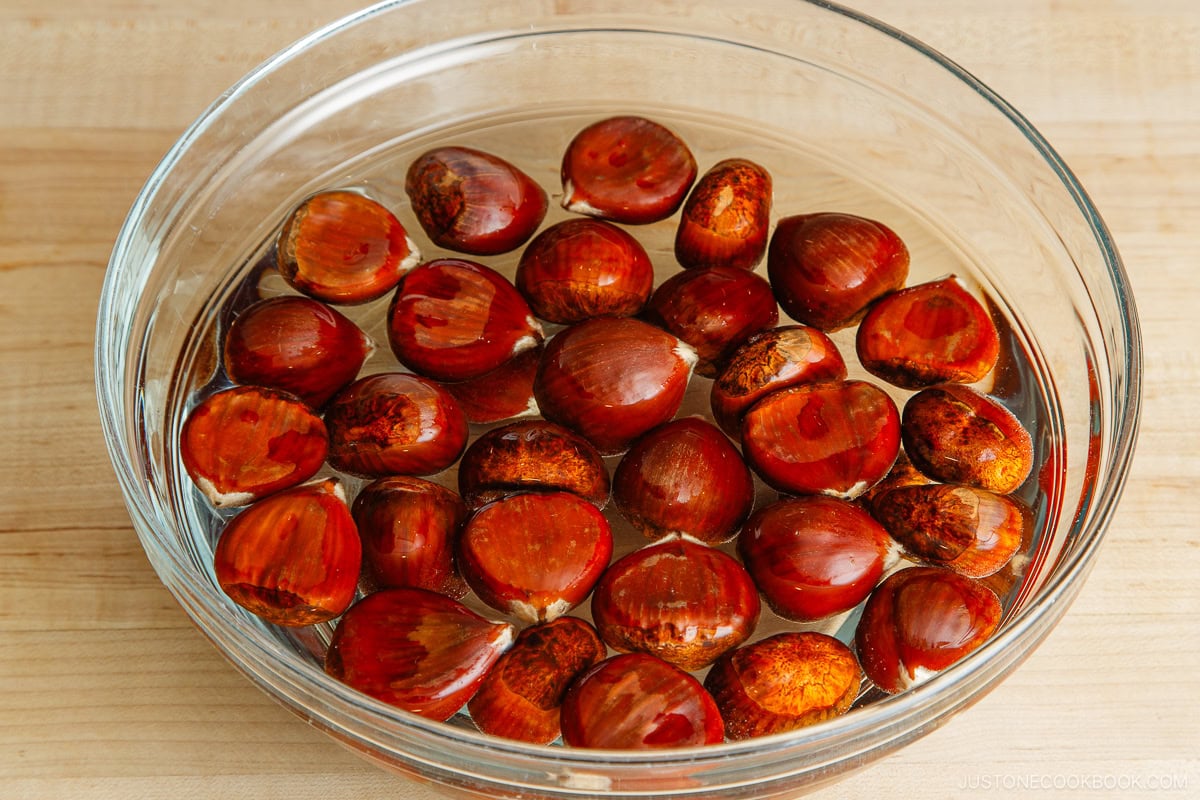
- Hold a chestnut in one hand and a pairing knife in the other. Carefully insert the corner of the knife under the bottom of the chestnut where the flat sides meet. Then, peel and remove the entire bottom. Tip: When the shell is tough and stubborn, place the chestnut on the cutting board, cut off the bottom, and then hold it to peel off the shell.

- Next, peel off a strip of shell along the side toward the chestnut tip.

- You should be able to peel off the outer shell with your fingers. Depending on the chestnut, the outer shell and inner skin may come off together, exposing the yellow flesh. The inner skin is the thin, papery brown layer that adheres to the nut itself.

- To create a beautiful presentation, peel away a thin layer of the bumpy chestnut flesh using the pairing knife. It's best to create a few wide, large cuts like the facets of a diamond rather than many small cuts. Soak the peeled chestnuts in a bowl of water for at least 30 minutes, changing the water a few times. Peel and soak the rest of the chestnuts.

- This one still has the thin, papery inner skin is still attached. Thinly peel off the bumpy flesh and inner skin together.
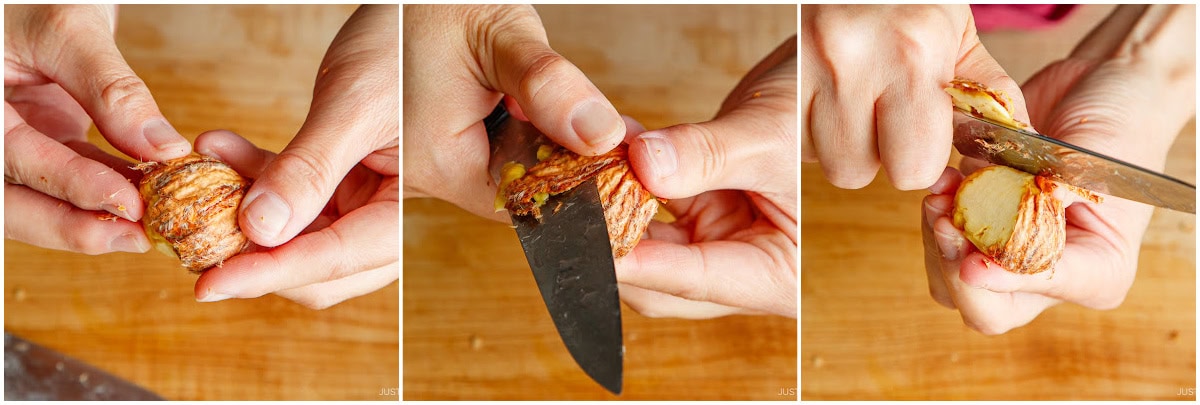
- Some chestnuts have folds and crevices where the outer shell is wedged. Use the edge of the knife to remove them. After soaking in a few changes of water, the chestnuts are a beautiful color. Tip: If your chestnuts are big, and cut them in half so that they cook evenly.
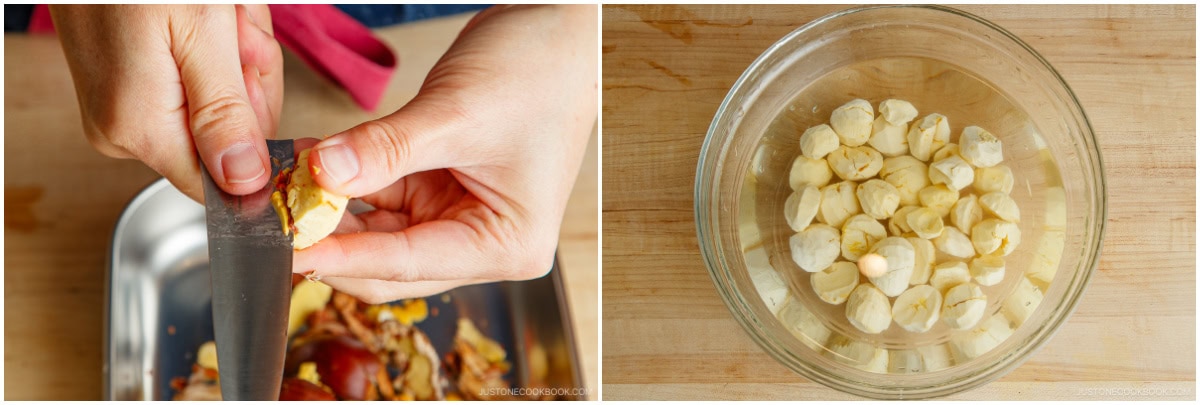
To Prepare the Ingredients
- Put 1⅞ cups uncooked Japanese short-grain white rice and ⅓ cup sweet rice/glutinous rice (mochigome) in a large bowl. Gently wash the rice with cold water and discard the cloudy water. Repeat this process about 3–4 times until the water becomes almost clear. Drain well.

- Put the well-drained rice and 2¼ cups water in a heavy-bottomed pot; I used a Hario Gohangama donabe, but you can use a Dutch oven instead. Tip: You can also cook this in a rice cooker.

- Add 1 Tbsp sake and ½ tsp Diamond Crystal kosher salt to the pot. Gently mix it all together, then level the rice.

- Place the chestnuts on top in a single layer, with the rounded sides facing up. Cover and let it soak for 20 to 30 minutes.

To Cook the Chestnut Rice
- Bring the rice to a boil over medium heat. Take a quick peek to see if the water is boiling (otherwise, do not open the lid). Once the water is boiling, turn the heat to low and cook covered for 12 to 13 minutes, or until the water is completely absorbed (take a quick peek). If there is still water left, close the lid and continue cooking for a little longer. If you're using the Gohangama, cook on medium-high heat until it starts to whistle, then cook for an additional 1 minute. Tip: If using a rice cooker, simply press Start and cook as usual.

- Remove the pot from the heat. Keep the lid on and let the rice steam for 15–20 minutes. This steaming time is a crucial part of the cooking process, so please do not skip it.

To Fluff and Serve
- Open the lid and set aside the best-looking chestnuts on a plate for serving.

- To fluff the rice, insert a rice paddle vertically into the cooked rice. Turn over a scoop of rice from the bottom. Then, use a slicing motion to separate the grains and gently incorporate the chestnuts. Repeat until fluffed. Serve the rice and top with the reserved chestnuts. Optionally, sprinkle Diamond Crystal kosher salt and toasted black sesame seeds on top.

To Store
- You can keep the leftovers in an airtight container and store in the freezer for up to a month.
Nutrition
Editor’s Note: This post was originally published on November 27, 2013. It was republished on November 4, 2024, with new images, a revised recipe, and more helpful information.









Nami san, I wonder if extra water should be added when placing peeled uncooked chestnuts directly into a rice cooker with the rice.
Should I use the rice cooker’s fill line in accordance with the amount of rice–regardless of kuri, or should I add more water? 🤔
Hello, Carina. Thank you for trying Nami’s recipe.
You can follow the mixed rice fill line inside the rice cooker pot or use the same amount of water in this recipe. Nami has already incorporated the extra liquid amount on the recipe card. I hope this helps!🙂
Thanks for the recipe! What should I pair it with? Hi from Shikoku!
Hello there, Bethany! Thank you for taking the time to read Nami’s post.
Here’s a link to an article that shows how to pair the dish.
https://www.justonecookbook.com/ichiju-sansai/
Matsutake season has arrived on Shikoku!
Matsutake soup or chawanmushi, salmon foil, and simmering green (this can be prepared with season green) are all possibilities.
https://www.justonecookbook.com/matsutake-clear-soup/
https://www.justonecookbook.com/chawanmushi-savory-steamed-egg-custard/#wprm-recipe-video-container-59984
https://www.justonecookbook.com/salmon-foil/
https://www.justonecookbook.com/simmered-fried-tofu-and-greens/
We hope this was helpful!
I made this with packaged pre-shelled/roasted chestnuts and it was delicious – I’ll definitely have to try it with fresh ones when they come back in season this fall!
Hi Esther! Thank you so much for trying Nami’s recipe and sharing your cooking experience with us! 🤗
Yes! Please try it with a fresh one from the season as well. We are sure you will enjoy it. Happy Cooking!
I’m so happy that Esther shared this! Thank you. Because I never saw fresh chestnuts here in germany. Always pre-shelled/roasted like Esthers. I scrolled to the comment section to ask about that, if there are no fresh chestnuts what to do? Could be that one’s craving for this rice and it’s not chestnut season or like me can’t find them fresh.
Well perhaps I could look in organic stores, perhaps there they sell them. I think here they are considered Baking and sweet dessert ingredients and not more. How narrow minded! I want to cook this rice! And am trying soon like Esther shared 🙂
We hope this works out for you, Anna! If you have tried it, please let us know what you think.
Happy Cooking!
So simple, yet so delicious! I used pre-peeled and steamed chestnuts, and cooked in the rice cooker. Thank you Nami!
Can I make this with rice cooker? I have been making all dinners out of your website for a week now and everything is delicious!
Hi Momo! Yes, you can use a rice cooker. Use regular setting or mix rice setting.
We hope this helps! Enjoy!
The time consuming part was cooking and cleaning the chestnuts, but the final result was very good: I really enjoyed the flavor of sake infused rice.
Hi Rolanda!
Yes! We totally agree with you.
Thank you for trying this recipe and for your kind feedback!
I love chestnuts, but not easy to find fresh ones. Can I substitute the dried chestnuts which can be found every day in the Chinese supermarkets around here in the Bay Area? I would cook this rice dish any time of the year, not just during the fall.
Hi Irene! I’ve never tried with cooked chestnuts before, but I think it’ll be okay. I’m just worried about the texture and color of it. If you give it a try, let us know!
Hey Nami! I LOVE your site!! One question, what type of main course would you normally make with this? Some type of fish? Would love your recommendations!
Hi Lucy! Thank you so much! Yes, since it’s a popular fall dish, I’d cook grilled fish – grilled sanma (pacific saury – but hard to find), mackerel, or salted salmon… simple dish works best. Because the chestnut is very subtle taste, I won’t match with heavy flavor main dish. 🙂
Hi Nami,
I just want to say a big THANK YOU to you to all the lovely Japanese recipes you share on this wonderful blog of yours. Your works are beautiful and I can tell how much effort you put into making each of these recipes and videos before sharing it with your readers. They are really great so keep up the good work!
I am a Singaporean but now living in Kyoto, studying Japanese. I am so glad to be able to refer to your website every time I want to cook some Japanese food. With access to the all the wide varieties of fresh food products here in Japan but do not know how to use or cook them, your blog really provides me with a lot of useful information and insights. So, thank you very very much. 🙂
It is now autumn now here in Japan and I see chestnuts, sanma fish, new rice etc etc in the market and I’m looking forward to cook them with the help of your recipes here. Please do not stop posting as I always am looking forward to your new recipes online! 🙂
Hi Fiona! Thank you so much for reading my blog and watching my videos. I appreciate your kind words and feedback about our work. 🙂
How wonderful that you’re living in Kyoto! You’ll have no problem getting ingredients I use in my recipes. 😉
Thank you again for your sweet words. Enjoy fall recipes. I’m so jealous that you can enjoy all the Japanese fall ingredients! I miss chestnuts, sanma, satsumaimo… mushrooms! Ah I love fall the best in Japan. 🙂
Thank you Cristina! I hope you’re having a nice Thanksgiving weekend as well! xo
Hello Nami, will definitely want to try cooking this chestnut rice. Chestnut is one of my favourite snack. Can we use all Japanese short grain rice instead of mixture of the glutinuous rice. Will it make any different in the flavour of this dish ?
Hi Ann! Yes, you can use only short grain rice (3 rice cooker cups). The flavor is pretty much same, but the texture will be less “mochi mochi” and less sticky texture and due to lack of glutinous rice. Hope you enjoy this dish! 🙂
I write a cookbook in Thai. There are some Japanese food in my menus. Your blog is my inspiration. I usually peel raw chestnuts and steam them. I will try this chest nut rice very soon. I did the sweet potato and it was so good.
Hi Torroong! Thank you so much for following my blog. 🙂 I personally think it’s hard to peel raw chestnuts. When the chestnuts are warm and absorbed some moisture, it’s easier to peel (still a lot of work to peel though. :)). I love Japanese sweet potato rice. So delicious!!
This looks good! I remember my mother roasting chestnuts in the oven this time of year: Yes, we had to peel them while they were still hot, as they’d be even harder to remove the shells when they were cold. If I crumbled the soft chestnuts inside, I’d get scolded, which may explain why I haven’t cooked chestnuts in a long time! 🙂
Just wondering: would it be possible to cook this in an electric rice cooker, particularly the “smart” kind with multiple settings?
Hi Hisaye! I love roasted chestnuts too! You can use your rice cooker (I usually use a rice cooker). A lot of people don’t have a rice cooker, so I made this rice with a pot. 🙂 Hope you enjoy this recipe!